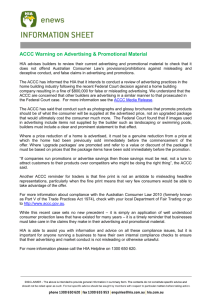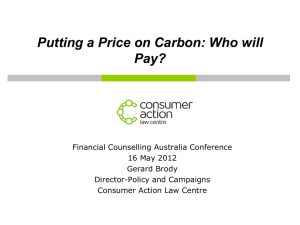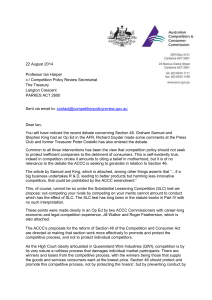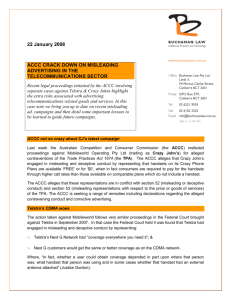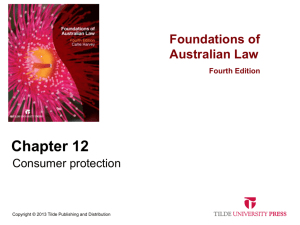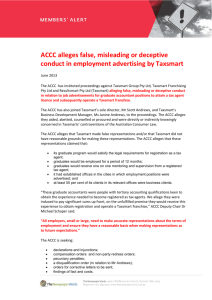National Product Liability Association 8 May, Melbourne ACCC deputy chair Louise Sylvan
advertisement
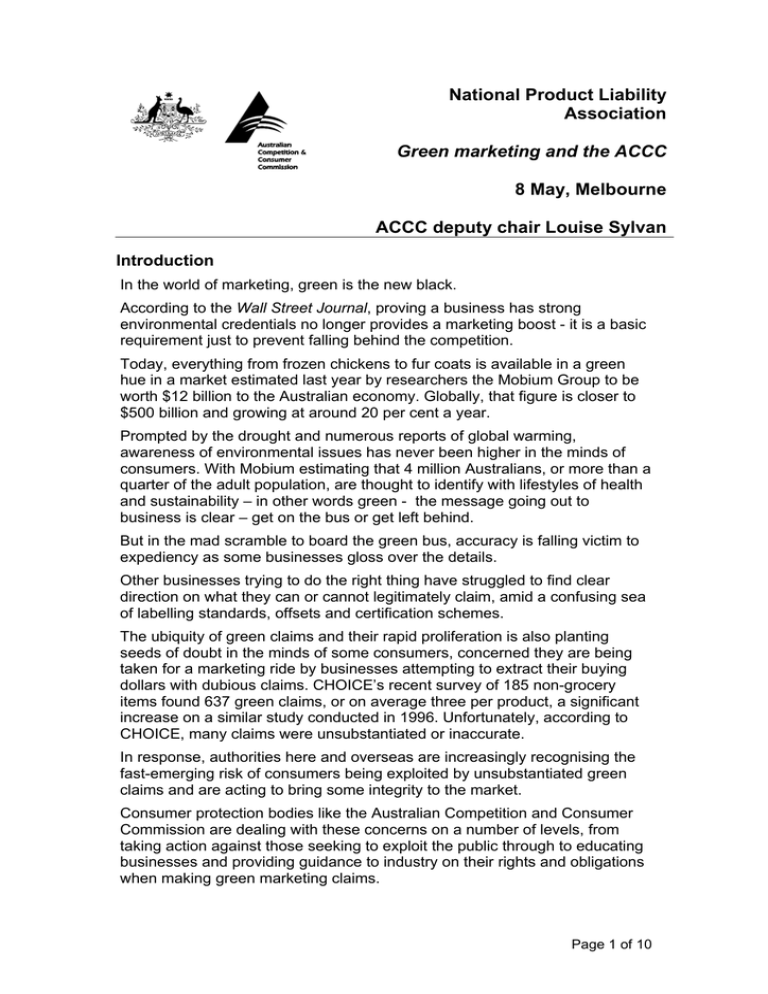
National Product Liability Association Green marketing and the ACCC 8 May, Melbourne ACCC deputy chair Louise Sylvan Introduction In the world of marketing, green is the new black. According to the Wall Street Journal, proving a business has strong environmental credentials no longer provides a marketing boost - it is a basic requirement just to prevent falling behind the competition. Today, everything from frozen chickens to fur coats is available in a green hue in a market estimated last year by researchers the Mobium Group to be worth $12 billion to the Australian economy. Globally, that figure is closer to $500 billion and growing at around 20 per cent a year. Prompted by the drought and numerous reports of global warming, awareness of environmental issues has never been higher in the minds of consumers. With Mobium estimating that 4 million Australians, or more than a quarter of the adult population, are thought to identify with lifestyles of health and sustainability – in other words green - the message going out to business is clear – get on the bus or get left behind. But in the mad scramble to board the green bus, accuracy is falling victim to expediency as some businesses gloss over the details. Other businesses trying to do the right thing have struggled to find clear direction on what they can or cannot legitimately claim, amid a confusing sea of labelling standards, offsets and certification schemes. The ubiquity of green claims and their rapid proliferation is also planting seeds of doubt in the minds of some consumers, concerned they are being taken for a marketing ride by businesses attempting to extract their buying dollars with dubious claims. CHOICE’s recent survey of 185 non-grocery items found 637 green claims, or on average three per product, a significant increase on a similar study conducted in 1996. Unfortunately, according to CHOICE, many claims were unsubstantiated or inaccurate. In response, authorities here and overseas are increasingly recognising the fast-emerging risk of consumers being exploited by unsubstantiated green claims and are acting to bring some integrity to the market. Consumer protection bodies like the Australian Competition and Consumer Commission are dealing with these concerns on a number of levels, from taking action against those seeking to exploit the public through to educating businesses and providing guidance to industry on their rights and obligations when making green marketing claims. Page 1 of 10 Today I’d like to talk to you about the work the ACCC and its counterparts overseas are doing to protect consumers and the messages we are trying to get out to those using the environment as a selling tool. A rising green tide Anecdotally we can see green claims sprouting like mushrooms all around us, in the shops, on public transport and on the advertising flashed before our eyes. Starting in July this year, you will even have the option of electing to be buried in a cardboard coffin in the middle of a koala sanctuary in NSW! But getting a quantitative measure on just how prevalent green marketing has become is not as easy as it might seem. One approach that has been deployed in the United States is looking at the business names being registered with the Trademarks Office. Dechert LLP runs an annual report on the number and names of trademarks registered in the US every year. In 2007 they found a huge jump in the number of applications for new trademarks, with green themed names responsible for much of the increase. For the first time in history the number of applications exceeded 300,000 as companies created a ‘green gridlock’ with multiple companies simultaneously applying for almost identical names. Green branding far outpaced overall growth in applications for the third year in a row. More than 100 different companies applied for a name using the phrase ‘go green’. The words ‘green’ and ‘clean’ were the most popular terms recorded in the study, but 900 applications also sought to attach the prefix ECO to products. There was also a 60 per cent year-on-year increase in companies wanting to use the word ‘earth’, and 700 applications were lodged to use the word ‘organic’, an increase of 57 per cent on the previous year. The evidence suggests this is not an isolated phenomenon, it is a worldwide trend which is making its way to our shores. Rising concern from the public Of course the rapid rise of green marketing is only a response to growing community concern about the environment. It appears shoppers are increasingly willing to support companies and products they feel are genuinely trying to reduce their impact. But with so many companies now painting themselves green all over the world, sorting the environmentally sound operators from those making harder to justify claims is getting more difficult for the public. With such confusing messages in the market, green scepticism is growing. This is being reflected in the complaints to the ACCC’s infocentre. In the first three months of this year the infocentre received 64 contacts on the subject, with roughly half those complaints about green claims being made by Page 2 of 10 competitive traders. If we had had 10 or 20 complaints throughout the year previously, that would have been a noticeable number. Among the concern being expressed to the ACCC was the validity of claims being made relating to energy savings or efficiency, the origin of green energy and pressure from door-to-door salesmen or telemarketers pushing green power products. Around a third of the complaints related to the use of ambiguous terms such as ‘100% eco friendly’, ‘carbon neutral’ or ‘world’s greenest’. Callers also complained about misleading advertising relating to the emissions levels of vehicles and the biodegradability of products. Equally of note were the number of calls to the ACCC seeking information or endorsement from businesses. There has been a spike in requests from business wanting to test their branding with the ACCC or find out more about what they can and cannot legitimately claim. The ACCC is obviously not in the business of providing a tick of approval to a business’s marketing strategy, but it can - and does - provide a lot of guidance to help those businesses make good decisions. Lack of clear standards One of the themes that comes out of the calls the ACCC receives from businesses is the lack of obvious go-to standards that businesses can use to cross-reference their marketing. This is particularly the case in relation to carbon emission offset schemes. Many businesses are attempting to mitigate the impact of their operations by purchasing credits in schemes that seek to offset carbon emissions through planting trees or supporting renewable energy. While heightened awareness from industry is welcome, there is some concern in the scientific community that offsetting is being seen as a bit of an easy way out of the problem. The weight of public opinion is that before even considering offsetting, businesses and individuals first need to consider changing their behaviour to reduce their emissions. This means considering options such as reconsidering activities like unnecessary long-distance travel or switching to renewable energy where feasible. Offsets should then be considered as a way of addressing those emissions that can’t be avoided by other means. It is not the ACCC’s role to comment on environmental issues as such. However, as offsets are effectively a consumer item, it does take responsibility for ensuring consumers who might be buying them are not being misled and understand that these schemes are not a licence to pollute. Currently in Australia there is no one universal standard for carbon offset schemes. In the absence of a defined standard, many businesses have adopted the Federal Government’s Greenhouse Friendly scheme, although the Voluntary Carbon Standard and other schemes such as those relied on in other jurisdictions overseas are partially filling this void. Page 3 of 10 There are also a number of state and territory based schemes which create a value for greenhouse gas emission abatements in operation at this time. These include renewable energy targets and greenhouse gas abatement schemes, which vary between jurisdictions. This is an evolving area. The Department of Climate Change, which was established in December last year, is working on a number of initiatives to help businesses reduce their contribution to climate change. The Greenhouse and Energy Reporting Act also came into effect last year. It will be a key element of any Australian emissions trading scheme that comes into place. At this stage, it is understood an emissions trading market will be in place between 2010 and 2012 and will obviously impact on the sale of carbon offsets. With the rapidly expanding market for carbon offsets, it is important that we get on top of these issues quickly. The World Bank recently estimated the global market for voluntary carbon emission permits reached $91 million in 2006 and is growing fast. In Australia, the Department of Climate Change has said it wants to see a standardisation of terms relating to offsets. The ACCC has also been working on the issue to provide some certainty and guidance to businesses. Later this year the ACCC will release guidance for consumers and businesses on carbon offsetting, designed to answer many of the questions that both sides have today. It will address issues that businesses offering offsets should consider, such as where offsets are coming from, how long they take to achieve and the way they are calculated. These are important issues to consumers, who want to be sure that the money they are spending is making a real difference. There is no way for an average person to verify that a particular stated amount of carbon dioxide has been removed from the atmosphere, making it critical that operators are held to account and made to justify their claims. The ACCC has also already released a guide to green marketing and the Trade Practices Act which is available in hard copy or electronically on our website. It discusses many of the sorts of issues I’ve raised here today and goes into more detail about the other certification schemes that exist in this area. The sorts of issues businesses need to consider when incorporating carbon offsetting into their marketing are complex. Firstly, they need to be clear about what exactly they are offering. Is the offset being sold designed to last for a specific time, say a year, or is the customer likely to expect, such as in the case of a commercial flight, that the offset has been calculated to cover the complete emission associated with that activity? Because of the lack of consistent standards in this area, businesses need to be specific about how they calculate emissions and the way in which they will be offset. As I said, this is a complex area, and it is important that both businesses and their customers understand this. Therefore customers may need to be provided with easy access to significant information about these schemes Page 4 of 10 and those advertising need to consider all the possible understandings or overall impression that might be established in the minds of customers. Green marketing and the TPA These complexities leave many businesses scratching their heads and asking, ‘so how do we know what we can and can’t claim?’. While specifics might be hard to come by at this stage, the advice that the ACCC is providing to businesses is that first and foremost, they need to comply with the long-standing provisions of the Trade Practices Act that are designed to protect consumers. Apart from any environmental consideration, these are concepts that I hope all businesses are aware they need to familiarise themselves with regardless of whether they are making environmental claims. They apply broadly to many aspects of a company’s interaction with its customers. The Act itself, as you are well aware, is a deliberately general and flexible piece of legislation. It is designed to spell out a roadmap of accountability and appropriate behaviour for businesses, rather than isolating exact measures that companies must comply with. The most relevant sections that potentially apply to green marketing are the provisions in Part V of the Act which prohibit misleading and deceptive conduct. It bears repeating that what the Act says is businesses must not engage in any conduct that is likely to mislead or deceive consumers – it doesn’t require that someone has actually been misled. It is also important to draw the distinction that motivation to mislead is not necessary either. Businesses with the best of intentions have potentially misled their customers in the past by not giving adequate consideration to the number of ways that their branding or product could be perceived. For instance, and of particular relevance in the green space, pictures or symbols used on packaging can be misleading if they give an overall impression that is not accurate. This has been an issue with food labelling in the past, but as more companies include images of nature designed to appeal to customers, it likely to be an issue in green marketing as well. If a light bulb has a picture of a windmill on its box, that may convey a meaning to some customers that it is somehow supporting, related to or drawing on renewable energy. If this is not the case, it may be misleading. Similarly, using endorsements or logos can be misleading or simply confusing if they are not well known or recognisable. Any claims of compliance with a certification must be verifiable and preference should be given to schemes that have wide industry, or government acceptance. One of the greatest areas of concern in the green marketing sphere is ambiguous naming of products or relatively meaningless claims. Very few consumers are atmospheric scientists, and can’t therefore be expected to know when environmental claims are likely to be untrue. This is why the ACCC takes a hard line on these issues. Page 5 of 10 For instance, a deodorant manufacturer might claim that its aerosol cans are free of Chlorofluorocarbon greenhouse gases. Such statements are today meaningless, as CFCs have been banned in virtually all products for many years. As demonstrated by the Trademarks Office example I gave earlier, words like ‘eco’, ‘clean’, and ‘green’ are increasingly finding their way into the names and descriptions of products on store shelves. Unfortunately, these are not particularly helpful to customers and without qualification become meaningless and potentially misleading. In many cases, they are best avoided. What exactly is eco friendly? Why does one product deserve to call itself greener than another? It is important to note that the matter of green claims is not simply a consumer protection issue and integrity of the market for consumers concern – this is a competition concern. Is a product deriving an unfair advantage over similar goods and competitiors on the same shelf because it is claiming to be better for the environment, where there is no evidence to support that? These are the sorts of problems that arise from the use of sweeping claims or green-inspired product names. Let me give a recent example. An air-conditioning manufacturer issued brochures claiming its products had ‘environmentally friendly HFC R407C added’ and that its products were ‘for a new ozone era – keeping the world green’. In fact, it was found the air conditioning units contained powerful greenhouse gases which were ozone depleting, contributed to global warming and did not benefit the environment. In general, the wider-ranging the claim, the more likely it is to mislead the public and therefore lead to a potential breach of the Act. A label on a washing machine that claims it has a four-star rating on the governmentrecognised WELS system provides much more useful and specific information than a label simply claiming the machine is energy efficient or environmentally friendly. The general rule can be summed up as this. If you can’t back a claim with verified scientific evidence, don’t make it. Sliding scale of concern The broad range of green claims being made means some will be of greater concern to the ACCC than others. In general, the green claims that are of most concern are the broad, sweeping statements that do not attempt to qualify their claims. For instance, “this product is 100% environmentally friendly”, “green” or “carbon smart”. Without qualification they are meaningless and potentially misleading. Those claims at the other end of the scale, those that represent less concern to the ACCC, are those that make specific, easy to verify claims. For example, “this tree planting project is a certified abatement under the Greenhouse Friendly program” – provided of course that the claim is true. Page 6 of 10 The severity of the concern is directly related to the type of response likely from the ACCC, as illustrated by the enforcement pyramid. At the bottom is the vast majority of work done in areas of providing advice and educating businesses and the public. This is the most often used tool to deal with and prevent low level concerns from developing. At the top are the most serious cases, those that cannot be easily dealt with through administrative processes and ultimately lead to court cases. Cases of green marketing that are found to be deliberately misleading or wilfully in breach of the law are likely to feel the full brunt of legal action from the regulator. Action taken It can be helpful to give a few examples of the sorts of green claims the ACCC has taken issue with lately. The ACCC recently raised concerns with GM Holden over its carbon offset advertising associated with the sale of SAAB cars. In a number of Saab is Green newspaper and magazine advertisements in July and August 2007, Saab made various statements including, ‘Grrrrrreen’, ‘Every Saab is green’, ‘Carbon emissions neutral across the entire Saab range’ and ‘Switch to carbon neutral motoring’ to promote the green Page 7 of 10 credentials of its motor vehicles. The advertisements also contained a statement that, in addition, Saab would plant 17 native trees in the first year following a Saab vehicle purchase as a carbon offset. The ACCC was concerned that the advertising could give consumers the impression that zero carbon emissions would be released by driving one of the vehicles and that the offsets would not extend to the life of the entire vehicle, as some customers might have understood from the advertising. Norway’s Consumer Ombudsman recently went one step further in announcing an outright ban on car manufacturers claiming green credentials for all cars, noting that no car was clean, green or otherwise good for the environment. Woolworths has also recently agreed to change the packaging of its Select brand tissue products after questions were raised about the claimed sustainability of overseas-sourced fibre being used. Most recently, De Longhi Australia provided court-enforceable undertakings to the ACCC to amend its advertising on portable air conditioners it claimed were environmentally friendly, contained non-harmful gases and were labelled as ECO. While De Longhi were using less harmful forms of refrigerants, the advertising was nevertheless considered by the ACCC to be potentially misleading, and the company agreed to alter it and publish corrective notices. Substantiation powers One of the issues considered as part of the Productivity Commission’s review of Australia’s consumer policy framework was the question of whether authorities should be granted substantiation powers. This would allow the ACCC to require those making claims to prove the backing behind them. Substantiation powers would place the onus back onto traders making the claims to prove that they are genuine. Such powers, if policy decision makers decide that these are useful for regulators to have, may discourage much of the puffery that exists in the green marketing sphere, as claims such as “most environmentally friendly”, “good for the planet” and so on would be very difficult to defend in any empirical way. International developments Australia is not the only country that is taking a harder line on environmental claims. In the United States the Federal Trade Commission is updating its environmental advertising standards to include terms such as ‘recyclable’ or ‘biodegradable’ in the advertising of products. It has also brought forward a review of its environmental marketing guidelines. In Europe, where carbon emissions have been capped progressively since 2005, regulators are investigating limiting the ability of companies to ‘buy’ their environmental stripes through purchasing offsets generated in other countries to reduce their costs. Page 8 of 10 The Netherlands has done some work looking at the use of trust marks and certification which is commonly used in relation to environmental claims. Norway has been among the most active European countries in the area of green claims. In addition to work relating to green claims and the automotive industry which I have already mentioned, Norway has been actively testing advertisements in the market and has been looking closely at the fuel and electricity industries. In 2005 the Nordic Consumer Ombudsman offices adopted a joint guideline on the use of ethical and environmental marketing claims. The Japanese government has been encouraging consumers to purchase environmentally friendly products, but has recently come up against concerns over green claims. In particular, a product that falsely claimed to be made of recycled paper has led to heightened consideration of how authorities should respond to misleading green claims. In March the Canadian Competition Bureau also announced it was preparing a crackdown on companies making false or misleading environmental claims and was to release guidelines that warn businesses making such claims that they need to be backed by hard scientific evidence. New Zealand has also taken an interest in green issues and has several matters currently under consideration. Many countries are moving in the same direction, towards increasing enforcement action against misleading green claims, while seeking at the same time to increase education through issuing guidance. Members of the International Consumer Protection and Enforcement Network are exchanging information on concerns in this area, which are now being raised in a number of international forums. Conclusion Community concern over the state of the environment is reaching unprecedented levels. The temptation to appeal to that concern is flashing like a big green dollar sign for many businesses. But the influx of environmentally concerned businesses threatens to become self-defeating as cynicism and distrust grow among consumers. Regulators and governments are also becoming increasingly focused on green marketing claims. The risk of running foul of the ACCC should be of concern to businesses that are making unjustified environmental claims. Of greater concern should be the risk of disenfranchising customers who will soon become distrustful of any environmental claims if they find they are being misled. Most businesses want to do the right thing by their customers, and where they are making genuine steps to reduce their impact on the environment they deserve to be able to promote that to their customers. Page 9 of 10 But the fundamental protections that have been with us for decades remain. Businesses must not engage in any conduct that is likely to mislead of deceive consumers. The ACCC has a number of publications designed to help both businesses and consumers work through these difficult issues, and will continue to issue further guidance later this year. I urge all businesses, and their advisors, to regularly review their trade practices compliance programs. Ensuring the principles spelled out under the Act are followed provides the best possible protection when making green marketing claims. Thank you. Page 10 of 10
